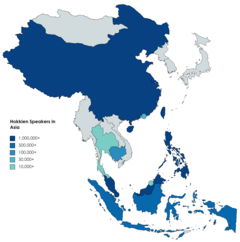
Back هاکین دیلی AZB Ho̍h-ló-oē CEB Hokkien Czech Hokkien German Hokla lingvo Esperanto Hokkien Spanish هاکین Persian Hokkien (langue) French Lingua hokkien Galician Bahasa Hokkien ID
| Hokkien | |
|---|---|
| Min Nan, Quanzhang, Amoy | |
 Koa-á books featuring Hokkien written in Chinese characters | |
| Region | China, Taiwan, and Southeast Asia |
| Ethnicity | Hokkien / Hoklo people |
Native speakers | tens of millions (est.)[a][2] |
Early forms | |
| Dialects | |
| Official status | |
Official language in | Taiwan[c] |
| Regulated by | Taiwan Ministry of Education |
| Language codes | |
| ISO 639-3 | nan (as part of Southern Min) |
| Glottolog | hokk1242 |
 Distribution of Southern Min languages, with Hokkien in dark green | |
 Polities by number of Hokkien speakers
≥1,000,000
≥500,000
≥100,000
≥50,000
Significant minority populations | |
| Hokkien | |||||||||||||||||||||||||||||||||||||||
|---|---|---|---|---|---|---|---|---|---|---|---|---|---|---|---|---|---|---|---|---|---|---|---|---|---|---|---|---|---|---|---|---|---|---|---|---|---|---|---|
| Traditional Chinese | 福建話 | ||||||||||||||||||||||||||||||||||||||
| Simplified Chinese | 福建话 | ||||||||||||||||||||||||||||||||||||||
| Hokkien POJ | Hok-kiàn-ōe / Hok-kiàn-ōa | ||||||||||||||||||||||||||||||||||||||
| |||||||||||||||||||||||||||||||||||||||
| Southern Min / Min Nan | |||||||||||||||||||||||||||||||||||||||
| Traditional Chinese | 閩南話/閩南語 | ||||||||||||||||||||||||||||||||||||||
| Simplified Chinese | 闽南话/闽南语 | ||||||||||||||||||||||||||||||||||||||
| Hokkien POJ | Bân-lâm-ōe / Bân-lâm-ōa / Bân-lâm-gú / Bân-lâm-gí / Bân-lâm-gír | ||||||||||||||||||||||||||||||||||||||
| |||||||||||||||||||||||||||||||||||||||
| Hoklo | |||||||||||||||||||||||||||||||||||||||
| Traditional Chinese | 福佬話 | ||||||||||||||||||||||||||||||||||||||
| Simplified Chinese | 福佬话 | ||||||||||||||||||||||||||||||||||||||
| Hokkien POJ | Ho̍h-ló-ōe / Hô-ló-ōe / Hō-ló-ōe | ||||||||||||||||||||||||||||||||||||||
| |||||||||||||||||||||||||||||||||||||||
| Lanlang | |||||||||||||||||||||||||||||||||||||||
| Traditional Chinese | 咱人話/咱儂話 | ||||||||||||||||||||||||||||||||||||||
| Simplified Chinese | 咱人话/咱侬话 | ||||||||||||||||||||||||||||||||||||||
| Hokkien POJ | Lán-lâng-ōe / Lán-nâng-ōe / Nán-nâng-ōe | ||||||||||||||||||||||||||||||||||||||
| |||||||||||||||||||||||||||||||||||||||
Hokkien (/ˈhɒkiɛn/ HOK-ee-en, US also /ˈhoʊkiɛn/ HOH-kee-en)[8] is a variety of the Southern Min languages, native to and originating from the Minnan region, in the southeastern part of Fujian in southeastern mainland China. It is also referred to as Quanzhang (Chinese: 泉漳; pinyin: Quánzhāng), from the first characters of the urban centers of Quanzhou and Zhangzhou.
Taiwanese Hokkien is one of the national languages in Taiwan. Hokkien is also widely spoken within the overseas Chinese diaspora in Singapore, Malaysia, the Philippines, Indonesia, Cambodia, Myanmar, Hong Kong, Thailand, Brunei, Vietnam, and elsewhere across the world. Mutual intelligibility between Hokkien dialects varies, but they are still held together by ethnolinguistic identity.[6]
In maritime Southeast Asia, Hokkien historically served as the lingua franca amongst overseas Chinese communities of all dialects and subgroups, and it remains today as the most spoken variety of Chinese in the region, including in Singapore, Malaysia, Philippines, Indonesia, and Brunei. This applied to a lesser extent to mainland Southeast Asia.[9] As a result of the significant influence and historical presence of its sizable overseas diaspora, certain considerable to ample amounts of Hokkien loanwords are also historically present in the languages it has had historical contact with in its sprachraum, such as Thai. Kelantan Peranakan Hokkien, in northern Malaya of Malaysia, and Hokaglish, spoken sporadically across the Philippines (especially Metro Manila), are also mixed languages, with Hokkien as the base lexifier.
- ^ Ethnologue. "Languages of Singapore – Ethnologue 2017". Retrieved 14 July 2017.
- ^ Chinese, Min Nan at Ethnologue (23rd ed., 2020)

- ^ Mei, Tsu-lin (1970), "Tones and prosody in Middle Chinese and the origin of the rising tone", Harvard Journal of Asiatic Studies, 30: 86–110, doi:10.2307/2718766, JSTOR 2718766
- ^ Pulleyblank, Edwin G. (1984), Middle Chinese: A study in Historical Phonology, Vancouver: University of British Columbia Press, p. 3, ISBN 978-0-7748-0192-8
- ^ Hammarström, Harald; Forkel, Robert; Haspelmath, Martin; Bank, Sebastian (10 July 2023). "Glottolog 4.8 - Min". Glottolog. Leipzig: Max Planck Institute for Evolutionary Anthropology. doi:10.5281/zenodo.7398962. Archived from the original on 13 October 2023. Retrieved 13 October 2023.
- ^ a b c d e f "Reclassifying ISO 639-3 [nan]: An Empirical Approach to Mutual Intelligibility and Ethnolinguistic Distinctions" (PDF). Archived from the original (PDF) on 19 September 2021.
- ^ 國家語言發展法. law.moj.gov.tw (in Chinese). Retrieved 22 May 2019.
- ^ "Hokkien, adjective & noun". Oxford English Dictionary. Retrieved 14 September 2023.
- ^ West, Barbara A. (2009). Encyclopedia of the Peoples of Asia and Oceania. Facts on File. pp. 289–290. ISBN 978-0-816-07109-8.
Cite error: There are <ref group=lower-alpha> tags or {{efn}} templates on this page, but the references will not show without a {{reflist|group=lower-alpha}} template or {{notelist}} template (see the help page).